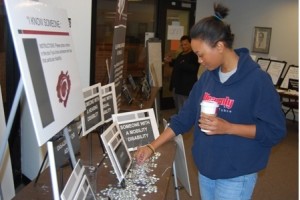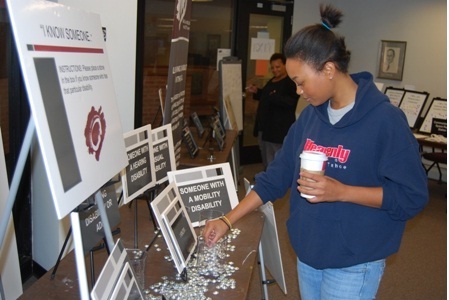Allies for Inclusion: The Ability Exhibit was on display from Monday, Oct. 24 to Thursday, Oct. 27. It worked to break down stereotypes associated with people who have disabilities.
The exhibit, which was held in Rollins 60, featured different stations where visitors could learn about what is defined as a disability and what is not. It also provided information to help people become more understanding.
The exhibit promotes the idea of becoming “disability allies,” advocates for treating the disabled as equals rather than people who are completely helpless. It stresses that the disabled are not lesser individuals than those in the general population.
The exhibit was developed by a graduate student from St. Louis University. It travels from college to college and is on a local circuit right now. It will soon be reaching its one year anniversary.
The exhibit was designed to challenge people on the way they think about disabled people and what they are and are not able to do.
“You have to do things [in this exhibit] that really make you think,” says Marie Cooper, head of disability service at Bucks and the organizer of the event.
One sign features a picture of a person with Downs’ syndrome that reads, “I am not learning disabled.” If a person removes that part of the sign, it says “I am diagnosed with a learning disorder.”
This helps people to overcome preconceived notions regarding the disabled. It gives students the opportunity to view these people from a different, more tolerant vantage point. This display was particularly effective.
The displays included in the exhibit are very interesting and informative. One, called the “Space Rope,” simulates “the communication distances used by people who are blind and have low vision.” Another, titled “Who Do You Know With Disabilities?” asks each visitor to place a stone in a bowl to represent each person he or she knows with a disability. “Person-First Language” asks the visitor to consider abandoning using labels to describe the disabled and to show respect.
The most poignant of the stations was the “Reflections” board, where students write down their thoughts and feelings after going through the exhibit.
“Help people in need,” proclaims one, “you’ll be surprised just how much you will learn”.
Another says “Not all great minds think alike!!”
“Know the person, not the disability. People first.”
“Everyone is equal. No human is less than just that.”
“Be aware of the abilities.”
Students also had the opportunity to sign a board pledging that they are an “Ally for Inclusion.”



